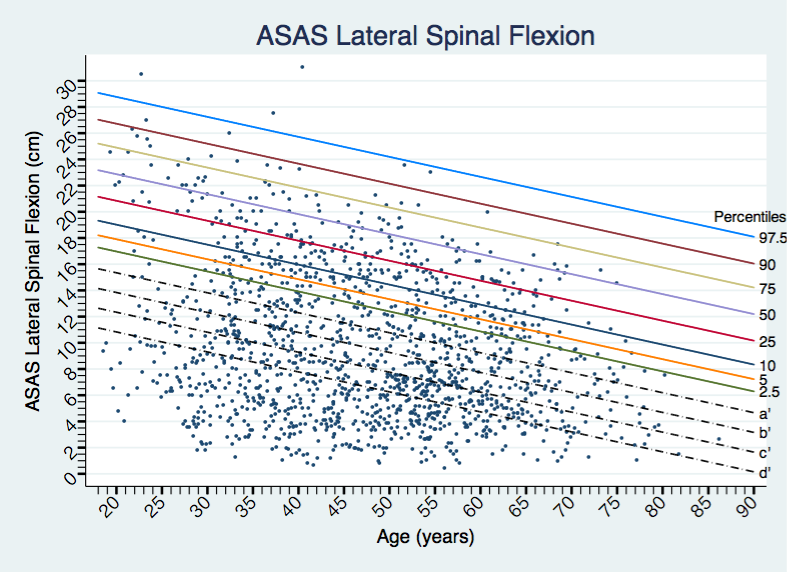Session Information
Session Type: Abstract Submissions (ACR)
Background/Purpose: We have shown that spinal mobility gets impaired in a fixed order in ankylosing spondylitis (AS), with the highest impairment in lumbar spine. We sought to investigate whether assessing few measures could capture full information on impairment in spinal mobility, which would be useful for clinical practice.
Methods: Patients from the Outcome in AS International Study (OASIS) were followed-up for 12 years in which spinal mobility was regularly measured (see Table). From a previous study in normal subjects (1), percentile curves (2.5th to 97.5th) were obtained for each of the spinal mobility measures (SMMs) (Figure). We added 4 parallel curves representing z-scores of 2.5, 3, 3.5 and 4 respectively (helplines a to d) to be able to plot impaired measures. Each of the SMMs was defined as impaired if the measurement fell below help-line a (first cutoff below normal subjects). The number of observations and of patients using baseline observation only with at least one SMM impaired was calculated. Of those, the proportion of observations or of patients, respectively, with each of the SMMs impaired was calculated. Furthermore, we investigated in how many cases would impairment in spinal mobility be missed if only a fixed number of SMMs was assessed.
Results: A total of 216 patients were included (70% males, mean(SD) age 44(13) years, mean symptom duration 21(12) years and 85% HLA-B27 positive). Impairment in spinal mobility was present in 1111 (78%) out of 1422 observations and in 161 (79%) out of the 203 patients with a complete baseline assessment. From the observations (and also patients) with at least one impaired SMM, in 83% (86% of the patients) lateral spinal flexion (LSF) was impaired, followed by Schober in 63% of them (58% of the patients). In one quarter of the observations, 1 SMM was impaired, in 32% 2 SMMs and in 18% 3 SMMs. At a patient-level, 1 SMM was impaired in 30% of the patients, 2 SMMs in 33% and 3 SMMs in 17%. If only LSF was measured, 17% of the observations (14% of the patients) with impairment in SMM would be missed. If additionally Schober was also measured, only 9% of the observations (and also of patients) would be missed (Table).
Conclusion: Impairment in spinal mobility can be investigated by assessing only 2 SMMs. We hereby recommend that measurement of LSF and Schober is sufficient to be informed about impairment in spinal mobility in patients with AS. Only if these are impaired it is important to assess additional measures.
References: (1) Ramiro et al. A&R 64(12):4173-4174
Figure – Lateral spinal flexion in function of age and with the percentile curves and help-lines derived from normal subjects
|
Table – Impairment of each of the spinal mobility measures in patients with AS in measurements with at least one SMM impaired |
||
|
|
Observation-level n (%) (N = 1111) |
Patient-level (baseline assessment) n (%) (N = 161) |
|
Impairment in each of the spinal mobility measures |
||
|
Lateral spinal flexion |
919 (83) |
138 (86) |
|
Schober |
696 (63) |
94 (58) |
|
Tragus-to-wall distance |
490 (44) |
62 (39) |
|
Cervical rotation |
349 (31) |
44 (27) |
|
Intermalleolar distance |
207 (19) |
27 (17) |
|
Chest expansion |
139 (13) |
17 (11) |
|
Impairment in spinal mobility missed if only the following measurements are performed |
||
|
Lateral spinal flexion |
192 (17) |
23 (14) |
|
Lateral spinal flexion + Schober
|
103 (9) |
14 (9) |
|
Lateral spinal flexion + Schober + tragus-to-wall distance
|
44 (4) |
7 (4) |
|
Lateral spinal flexion + Schober + tragus-to-wall distance + cervical rotation
|
14 (1) |
1 (1) |
|
Lateral spinal flexion + Schober + tragus-to-wall distance + cervical rotation + intermalleolar distance
|
3 (0) |
1 (1) |
Disclosure:
S. Ramiro,
None;
R. Landewé,
None;
D. van der Heijde,
None;
C. Stolwijk,
None;
M. Dougados,
None;
F. Van den Bosch,
None;
A. M. van Tubergen,
None.
« Back to 2013 ACR/ARHP Annual Meeting
ACR Meeting Abstracts - https://acrabstracts.org/abstract/measurement-of-lateral-spinal-flexion-and-schober-is-sufficient-to-be-informed-about-spinal-mobility-in-patients-with-ankylosing-spondylitis-12-year-oasis-results/

